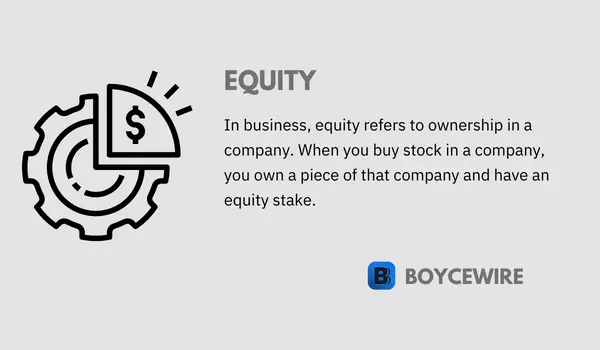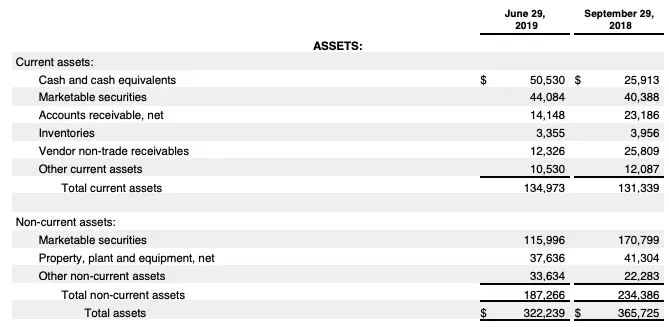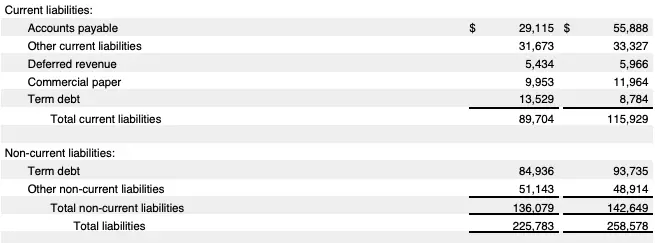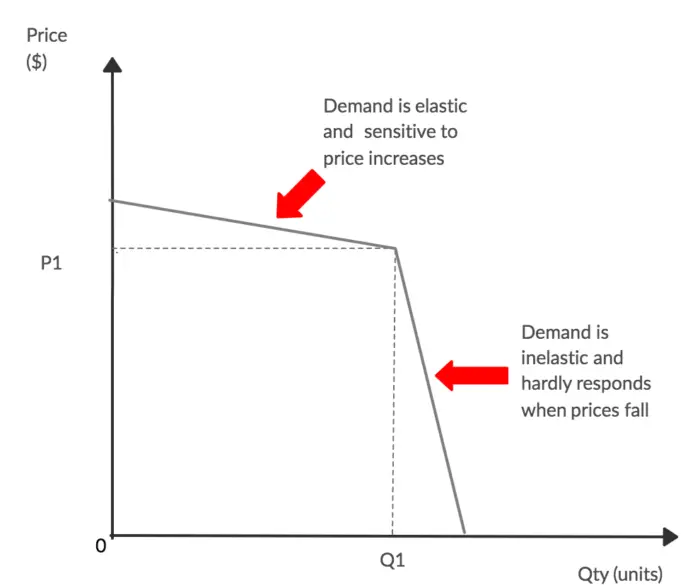Equity: Definition, How it works, Types & Formula

What is Equity
Equity refers to the value of an individuals ownership of an asset where there is an associated debt or other liability. In other words, it’s the value which is left over after any financial obligations are taken into consideration. This can be calculated using the formula: Equity = Assets – Liabilities.
Equity is also known as a companies ‘net assets’. For example, a company may have assets worth $100 million. Yet it may owe $90 million to banks and other financial institutions. So although it owns $100 million in assets, it must pay $90 million – leaving it with $10 million worth of equity.
In the event of liquidation, the equity is what would be available to shareholders of the company. During this process, the companies assets are sold, with the funds going to over its debts or other liabilities. Once these are paid off, we are left with the equity. In essence, this can help paint a better picture of the companies accounting value.
Key Points
- Equity represents the ownership of an asset.
- Equity = Assets – Liabilities.
- As a shareholder, equity represents their stake in the company, which is shown on the balance sheet.
Equity is one of the most important parts on a companies balance sheet. It helps analysts and investors determine the firms financial health. For example, a firm with negative equity owes more money than it owns. In other words, the company is in debt.
How it Works
Equity represents the funds invested into a business by its owners. For example, let’s look at the accounting equation, Assets = Liabilities – Equity. A business can fund its operations one of two ways. First of all, it can borrow from third parties such as banks, which acts as a liability. Alternatively, it can choose the funds invested in it by its owners. In other words, the equity of the firm.
For example, a business may have assets worth $5 million and liabilities of $1 million. This would leave an equity stake of $4 million. In order to grow the business, it may look to take out an additional loan of $1 million. This will increase its liabilities to $2 million in the short term.
Depending on how that money is spent, this could reduce the equity value to $3 million. However, if the money is spent well, and the company grows, it could increase the value of its assets. If the assets value increases, this may outweigh the loss due to increased liabilities.
In essence, equity can be seen as ‘net assets’. Yet it represents the value by which owners invested in the firm. This can increase and decrease over time as the firm’s assets and liabilities fluctuate.
Types of Equity
Equity can come in may shapes and sizes, which is why it can sometimes become confusing.
Brand
Companies such as Apple, Disney, and Gucci all benefit from their brand. Customers are willing to spend above and beyond because of the logo. The logo represents trust, value, and quality, which the customer can rely on. This is known as an intangible asset and is included on the balance sheet. Alongside tangible assets, this makes up the companies total assets.
Measuring brand equity can be extremely difficult as there are many factors which can affect its value. These include brand recognition, service, quality, and even aspirational value – among others. So this can be quite difficult to value to a great deal of accuracy.
For a more simplified calculation of brand equity, we can compare the product to a generic alternative. For example, a branded Nike t-shirt costs $20. A generic non-branded t-shirt costs $5. So the brand equity can be seen as the difference between the two, which in this case is $15. This is the value which customers place over and above a generic alternative in order to obtain the brand.
Home
Home equity is the value that the owner has in their property. In other words, it’s what they would have left once they sell their house and pay off their mortgage. This falls back to the previous equation: Equity = Assets – Liabilities.
For example, Mr White owns a house worth $500,000 and owes $350,000 on his mortgage. In this case, the asset is the house, which is worth $500,000. Once we minus the liability, the mortgage, we are then left with the home equity. Asset ($500,000) – Liabilities ($350,000) = $150,000.
When Mr White sells his home and pays off his mortgage, he will be left with $150,000. This represents how much of the house he actually owns – which originates from the deposit and payments Mr White made.
Should the house price fall below $350,000, then Mr White would find himself in ‘negative equity’. In other words, his liabilities (mortgage), is more than his asset (the house). So if he was to sell the property, he would not have enough to cover his debts.
Personal (Net worth)
Personal equity, otherwise known as net worth, represents an individuals wealth once liabilities are taken into consideration. To calculate this, we would need to consider all of a persons individual assets. These might include:
- Cash
- Real Estate
- Motor Vehicles
- Personal items such as phones, laptops
- White goods and other household items
- Investments
Once all these individual assets are tallied up, we must then subtract any liabilities. Examples include:
- Mortgages
- Credit card debt
- Shared ownership
- Student loans
- Credit card debt
- Unpaid taxes
Once these are taken away from personal assets, we are left with an individuals personal equity.
Positive and Negative
When an individual has positive equity, they have assets that are greater than their liabilities. For example, Doug owns a Donut store. He owns the land, building, and equipment in it. In total, this is valued at $300,000. However, he has a mortgage and other credit card debts which amount to $230,000. These are his liabilities.
If we take Doug’s assets, $300,000, and minus his liabilities, $230,000, we are left with $70,000. This represents Doug’s equity in the business. In this case, it’s a positive value.
Now, let’s consider Doug’s store again and say he has taken out more debt, which takes his total liabilities up to $350,000. Assuming his assets are still worth $300,000, he would be left with minus $50,000. Even if he sold all his assets, he would not have enough to cover his debts. This is known as negative equity.
Shareholder
Shareholder equity refers to the ownership of the firm which is shared between many other investors. The meaning of equity remains the same. It is equal to the companies assets minus its liabilities. The only difference is that it refers to what is owned by the shareholder.
Shareholders can either own preferred stock or common stock. Both represent ownership of the company, with the companies equity being split between shareholders. For example, a company may go bankrupt and have to liquidate its assets. It must first pay off its liabilities and only then can it return funds to shareholders. The money that would be left over to pay shareholders is known as the shareholder equity.
Formula and How to Calculate Shareholders’ Equity
In order to calculate shareholders’ equity, you can use the formula derived from the accounting equation.

First of all, you will need to find the firms total assets on the balance sheet. This can be found by searching for ‘current assets’ on the PDF. An example of what this looks like can be seen below using Apple’s 2019 Consolidated Financial Statement.

Here, we can see all the various assets that Apple owns. This ranges from cash to inventories, to accounts receivable. Also included are ‘non-current’ assets. These are essentially long-term assets which are not easily converted into cash. Examples include property and long-term investments such as bonds.
In this example of Apple’s balance sheet, we can see the company has total assets worth $332,239. These figures are in millions, so this would amount to roughly $332 billion.
Next, we must subtract the firms liabilities. This can be seen below from Apple’s 2019 Consolidated Financial Statement.

A companies liabilities consist of accounts payable, deferred revenue, commercial paper, and long-term debt with an upcoming expiry. There are also ‘non-current’ liabilities, which are essentially long term liabilities which are due in the future. These are generally long-term debts which have a payment date of sometime in the future.
In this example, we can see that Apple’s total liabilities amount to $225,783 (noting the right column is for 2018). Again, this figure is in millions, so this amounts to roughly $226 billion.
So to calculate Apple’s Shareholder Equity, we can take its total assets, $332 billion, and minus its liabilities, $226 billion, leaving us with roughly $96 billion.
Equity vs. Return on Equity
Return on Equity (RoE) is a financial performance measure that looks at how efficient the firm is at turning investments into profits. It is calculated by dividing net income by shareholder equity. This then shows us how efficiently each dollar’s investment has been used.
For example, a firm may have a net income of $200,000. If its shareholder equity is worth $400,000, then we would dividend $200,000 by $400,000. This would leave us with a RoE of 50% or $0.50 for every $1 of shareholder investment.
By contrast, equity refers to the value of an individuals ownership of an asset. Stockholders are an example of such. They own a share of a company in return for their investment. This is in contrast to RoE, which is looks more at profitability than the firms financial shape.
FAQs
In finance, equity refers to the value of an individuals ownership of an asset. This could range from home ownership to shareholdings to a companies brand value.
Equity = Assets – Liabilities. This calculates how much is left over once the company pays its debts. For example, if the company goes bankrupt, it will go into liquidation. It will have to sell its assets and use those funds to pay off its various liabilities such as debts. Once it has sold its assets and paid off its liabilities, we have what is left over for shareholders. However, this can also be applied to other circumstances such as home ownership. For instance, the value of a home might be worth $500,000, but the owner has a $300,000 mortgage on it. Only once that liability is paid off, are we left with the home owners equity in the house.
Equity release is the process of selling part ownership of an asset. For example, a home owner may own 100 percent of their house. However, they may want some additional funds, so sell 20 percent of this to an investor.
About Paul
Paul Boyce is an economics editor with over 10 years experience in the industry. Currently working as a consultant within the financial services sector, Paul is the CEO and chief editor of BoyceWire. He has written publications for FEE, the Mises Institute, and many others.

Further Reading
 Economic System: Definition, Types & Examples - An economic system is a network that forms the economic relationships between individuals in society.
Economic System: Definition, Types & Examples - An economic system is a network that forms the economic relationships between individuals in society.  Command Economy: Definition, Examples, Pros & Cons - A Command economy is where economic resources are controlled by centralised powers.
Command Economy: Definition, Examples, Pros & Cons - A Command economy is where economic resources are controlled by centralised powers.  Oligopoly: Definition, Characteristics & Examples - Oligopoly is derived from the Latin ‘olígoi’ – meaning “few”, and ‘pōléō’ – meaning “to sell”. So loosely translated, it…
Oligopoly: Definition, Characteristics & Examples - Oligopoly is derived from the Latin ‘olígoi’ – meaning “few”, and ‘pōléō’ – meaning “to sell”. So loosely translated, it… 